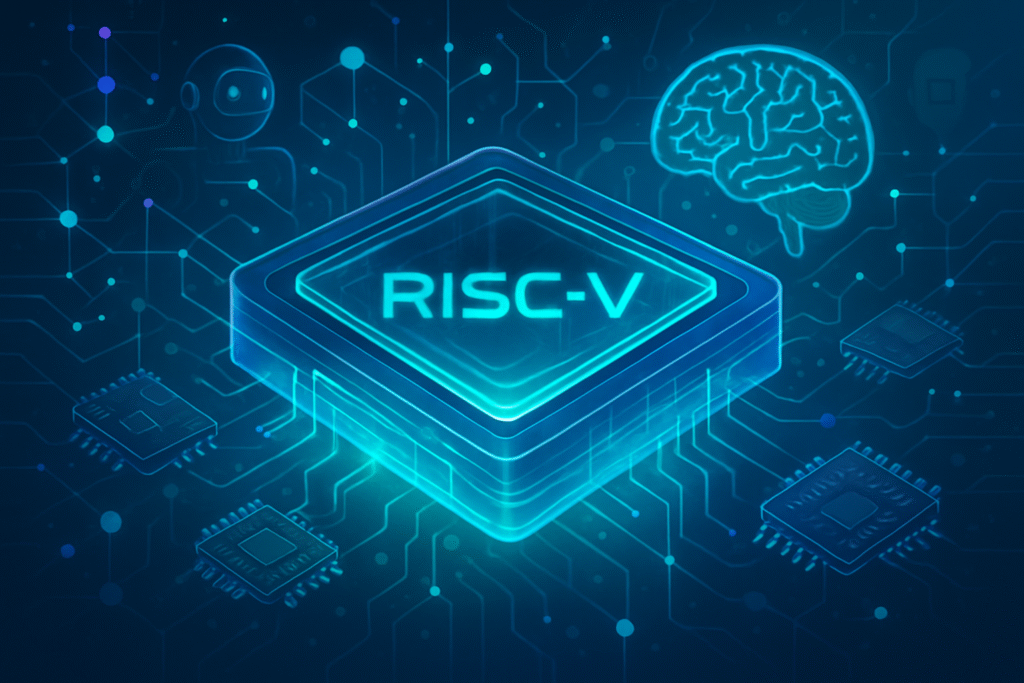
RISC-V, an open-standard instruction set architecture (ISA), is rapidly reshaping the artificial intelligence (AI) chip landscape by dismantling traditional barriers to entry and catalyzing unprecedented innovation. Its royalty-free, modular, and extensible nature directly challenges proprietary architectures like ARM (NASDAQ: ARM) and x86, immediately empowering a new wave of developers and fostering a dynamic, collaborative ecosystem. By eliminating costly licensing fees, RISC-V democratizes chip design, making advanced AI hardware development accessible to startups, researchers, and even established tech giants. This freedom from vendor lock-in translates into faster iteration, greater creativity, and more flexible development cycles, enabling the creation of highly specialized processors tailored precisely to diverse AI workloads, from power-efficient edge devices to high-performance data center GPUs.
The immediate significance of RISC-V in the AI domain lies in its profound impact on customization and efficiency. Its inherent flexibility allows designers to integrate custom instructions and accelerators, such as specialized tensor units and Neural Processing Units (NPUs), optimized for specific deep learning tasks and demanding AI algorithms. This not only enhances performance and power efficiency but also enables a software-focused approach to hardware design, fostering a unified programming model across various AI processing units. With over 10 billion RISC-V cores already shipped by late 2022 and projections indicating a substantial surge in adoption, the open-source architecture is demonstrably driving innovation and offering nations a path toward semiconductor independence, fundamentally transforming how AI hardware is conceived, developed, and deployed globally.
The Technical Core: How RISC-V is Architecting AI's Future
The RISC-V instruction set architecture (ISA) is rapidly emerging as a significant player in the development of AI chips, offering unique advantages over traditional proprietary architectures like x86 and ARM (NASDAQ: ARM). Its open-source nature, modular design, and extensibility make it particularly well-suited for the specialized and evolving demands of AI workloads.
RISC-V (pronounced "risk-five") is an open-standard ISA based on Reduced Instruction Set Computer (RISC) principles. Unlike proprietary ISAs, RISC-V's specifications are released under permissive open-source licenses, allowing anyone to implement it without paying royalties or licensing fees. Developed at the University of California, Berkeley, in 2010, the standard is now managed by RISC-V International, a non-profit organization promoting collaboration and innovation across the industry. The core principle of RISC-V is simplicity and efficiency in instruction execution. It features a small, mandatory base instruction set (e.g., RV32I for 32-bit and RV64I for 64-bit) that can be augmented with optional extensions, allowing designers to tailor the architecture to specific application requirements, optimizing for power, performance, and area (PPA).
The open-source nature of RISC-V provides several key advantages for AI. First, the absence of licensing fees significantly reduces development costs and lowers barriers to entry for startups and smaller companies, fostering innovation. Second, RISC-V's modular design offers unparalleled customizability, allowing designers to add application-specific instructions and acceleration hardware to optimize performance and power efficiency for targeted AI and machine learning workloads. This is crucial for AI, where diverse workloads demand specialized hardware. Third, transparency and collaboration are fostered, enabling a global community to innovate and share resources without vendor lock-in, accelerating the development of new processor innovations and security features.
Technically, RISC-V is particularly appealing for AI chips due to its extensibility and focus on parallel processing. Its custom extensions allow designers to tailor processors for specific AI tasks like neural network inference and training, a significant advantage over fixed proprietary architectures. The RISC-V Vector Extension (RVV) is crucial for AI and machine learning, which involve large datasets and repetitive computations. RVV introduces variable-length vector registers, providing greater flexibility and scalability, and is specifically designed to support AI/ML vectorized operations for neural networks. Furthermore, ongoing developments include extensions for critical AI data types like FP16 and BF16, and efforts toward a Matrix Multiplication extension.
RISC-V presents a distinct alternative to x86 and ARM (NASDAQ: ARM). Unlike x86 (primarily Intel (NASDAQ: INTC) and AMD (NASDAQ: AMD)) and ARM's proprietary, fee-based licensing models, RISC-V is royalty-free and open. This enables deep customization at the instruction set level, which is largely restricted in x86 and ARM. While x86 offers powerful computing for high-performance computing and ARM excels in power efficiency for mobile, RISC-V's customizability allows for tailored solutions that can achieve optimal power and performance for specific AI workloads. Some estimates suggest RISC-V can exhibit approximately a 3x advantage in computational performance per watt compared to ARM and x86 in certain scenarios. Although its ecosystem is still maturing compared to x86 and ARM, significant industry collaboration, including Google's commitment to full Android support on RISC-V, is rapidly expanding its software and tooling.
The AI research community and industry experts have shown strong and accelerating interest in RISC-V. Research firm Semico forecasts a staggering 73.6% annual growth in chips incorporating RISC-V technology, with 25 billion AI chips by 2027. Omdia predicts RISC-V processors to account for almost a quarter of the global market by 2030, with shipments increasing by 50% annually. Companies like SiFive, Esperanto Technologies, Tenstorrent, Axelera AI, and BrainChip are actively developing RISC-V-based solutions for various AI applications. Tech giants such as Meta (NASDAQ: META) and Google (NASDAQ: GOOGL) are investing in RISC-V for custom in-house AI accelerators, and NVIDIA (NASDAQ: NVDA) is strategically supporting CUDA on RISC-V, signifying a major shift. Experts emphasize RISC-V's suitability for novel AI applications where existing ARM or x86 solutions are not entrenched, highlighting its efficiency and scalability for edge AI.
Reshaping the Competitive Landscape: Winners and Challengers
RISC-V's open, modular, and extensible nature makes it a natural fit for AI-native, domain-specific computing, from low-power edge inference to data center transformer workloads. This flexibility allows designers to tightly integrate specialized hardware, such as Neural Processing Units (NPUs) for inference acceleration, custom tensor acceleration engines for matrix multiplications, and Compute-in-Memory (CiM) architectures for energy-efficient edge AI. This customization capability means that hardware can adapt to the specific requirements of modern AI software, leading to faster iteration, reduced time-to-value, and lower costs.
For AI companies, RISC-V offers several key advantages. Reduced development costs, freedom from vendor lock-in, and the ability to achieve domain-specific customization are paramount. It also promotes a unified programming model across CPU, GPU, and NPU, simplifying code efficiency and accelerating development cycles. The ability to introduce custom instructions directly, bypassing lengthy vendor approval cycles, further speeds up the deployment of new AI solutions.
Numerous entities stand to benefit significantly. AI startups, unburdened by legacy architectures, can innovate rapidly with custom silicon. Companies like SiFive, Esperanto Technologies, Tenstorrent, Semidynamics, SpacemiT, Ventana, Codasip, Andes Technology, Canaan Creative, and Alibaba's T-Head are actively pushing boundaries with RISC-V. Hyperscalers and cloud providers, including Google (NASDAQ: GOOGL) and Meta (NASDAQ: META), can leverage RISC-V to design custom, domain-specific AI silicon, optimizing their infrastructure for specific workloads and achieving better cost, speed, and sustainability trade-offs. Companies focused on Edge AI and IoT will find RISC-V's efficiency and low-power capabilities ideal. Even NVIDIA (NASDAQ: NVDA) benefits strategically by porting its CUDA AI acceleration stack to RISC-V, maintaining GPU dominance while reducing architectural dependence on x86 or ARM CPUs and expanding market reach.
The rise of RISC-V introduces profound competitive implications for established players. NVIDIA's (NASDAQ: NVDA) decision to support CUDA on RISC-V is a strategic move that allows its powerful GPU accelerators to be managed by an open-source CPU, freeing it from traditional reliance on x86 (Intel (NASDAQ: INTC)/AMD (NASDAQ: AMD)) or ARM (NASDAQ: ARM) CPUs. This strengthens NVIDIA's ecosystem dominance and opens new markets. Intel (NASDAQ: INTC) and AMD (NASDAQ: AMD) face potential marginalization as companies can now use royalty-free RISC-V alternatives to host CUDA workloads, circumventing x86 licensing fees, which could erode their traditional CPU market share in AI systems. ARM (NASDAQ: ARM) faces the most significant competitive threat; its proprietary licensing model is directly challenged by RISC-V's royalty-free nature, particularly in high-volume, cost-sensitive markets like IoT and automotive, where RISC-V offers greater flexibility and cost-effectiveness. Some analysts suggest this could be an "existential threat" to ARM.
RISC-V's impact could disrupt several areas. It directly challenges the dominance of proprietary ISAs, potentially leading to a shift away from x86 and ARM in specialized AI accelerators. The ability to integrate CPU, GPU, and AI capabilities into a single, unified RISC-V core could disrupt traditional processor designs. Its flexibility also enables developers to rapidly integrate new AI/ML algorithms into hardware designs, leading to faster innovation cycles. Furthermore, RISC-V offers an alternative platform for countries and firms to design chip architectures without IP and cost constraints, reducing dependency on specific vendors and potentially altering global chip supply chains. The strategic advantages include enhanced customization and differentiation, cost-effectiveness, technological independence, accelerated innovation, and ecosystem expansion, cementing RISC-V's role as a transformative force in the AI chip landscape.
A New Paradigm: Wider Significance in the AI Landscape
RISC-V's open-standard instruction set architecture (ISA) is rapidly gaining prominence and is poised to significantly impact the broader AI landscape and its trends. Its open-source ethos, flexibility, and customizability are driving a paradigm shift in hardware development for artificial intelligence, challenging traditional proprietary architectures.
RISC-V aligns perfectly with several key AI trends, particularly the demand for specialized, efficient, and customizable hardware. It is democratizing AI hardware by lowering the barrier to entry for chip design, enabling a broader range of companies and researchers to develop custom AI processors without expensive licensing fees. This open-source approach fosters a community-driven development model, mirroring the impact of Linux on software. Furthermore, RISC-V's modular design and optional extensions, such as the 'V' extension for vector processing, allow designers to create highly specialized processors optimized for specific AI tasks. This enables hardware-software co-design, accelerating innovation cycles and time-to-market for new AI solutions, from low-power edge inference to high-performance data center training. Shipments of RISC-V-based chips for edge AI are projected to reach 129 million by 2030, and major tech companies like Google (NASDAQ: GOOGL) and Meta (NASDAQ: META) are investing in RISC-V to power their custom AI solutions and data centers. NVIDIA (NASDAQ: NVDA) also shipped 1 billion RISC-V cores in its GPUs in 2024, often serving as co-processors or accelerators.
The wider adoption of RISC-V in AI is expected to have profound impacts. It will lead to increased innovation and competition by breaking vendor lock-in and offering a royalty-free alternative, stimulating diverse AI hardware architectures and faster integration of new AI/ML algorithms into hardware. Reduced costs, through the elimination of licensing fees, will make advanced AI computing capabilities more accessible. Critically, RISC-V enables digital sovereignty and local innovation, allowing countries and regions to develop independent technological infrastructures, reducing reliance on external proprietary solutions. The flexibility of RISC-V also leads to accelerated development cycles and promotes unprecedented international collaboration.
Despite its promise, RISC-V's expansion in AI also presents challenges. A primary concern is the potential for fragmentation if too many non-standard, proprietary extensions are developed without being ratified by the community, which could hinder interoperability. However, RISC-V International maintains rigorous standardization processes to mitigate this. The ecosystem's maturity, while rapidly growing, is still catching up to the decades-old ecosystems of ARM (NASDAQ: ARM) and x86, particularly concerning software stacks, optimized compilers, and widespread application support. Initiatives like the RISE project, involving Google (NASDAQ: GOOGL), MediaTek, and Intel (NASDAQ: INTC), aim to accelerate software development for RISC-V. Security is another concern; while openness can lead to robust security through public scrutiny, there's also a risk of vulnerabilities. The RISC-V community is actively researching security solutions, including hardware-assisted security units.
RISC-V's trajectory in AI draws parallels with several transformative moments in computing and AI history. It is often likened to the "Linux of Hardware," democratizing operating system development. Its challenge to proprietary architectures is analogous to how ARM successfully challenged x86's dominance in mobile computing. The shift towards specialized AI accelerators enabled by RISC-V echoes the pivotal role GPUs played in accelerating AI/ML tasks, moving beyond general-purpose CPUs to highly optimized hardware. Its evolution from an academic project to a major technological trend, now adopted by billions of devices, reflects a pattern seen in other successful technological breakthroughs. This era demands a departure from universal processor architectures towards workload-specific designs, and RISC-V's modularity and extensibility are perfectly suited for this trend, allowing for precise tailoring of hardware to evolving algorithmic demands.
The Road Ahead: Future Developments and Predictions
RISC-V is rapidly emerging as a transformative force in the Artificial Intelligence (AI) landscape, driven by its open-source nature, flexibility, and efficiency. This instruction set architecture (ISA) is poised to enable significant advancements in AI, from edge computing to high-performance data centers.
In the near term (1-3 years), RISC-V is expected to solidify its presence in embedded systems, IoT, and edge AI applications, primarily due to its power efficiency and scalability. We will see a continued maturation of the RISC-V ecosystem, with improved availability of development tools, compilers (like GCC and LLVM), and simulators. A key development will be the increasing implementation of highly optimized RISC-V Vector (RVV) instructions, crucial for AI/Machine Learning (ML) computations. Initiatives like the RISC-V Software Ecosystem (RISE) project, supported by major industry players such as Google (NASDAQ: GOOGL), Intel (NASDAQ: INTC), NVIDIA (NASDAQ: NVDA), and Qualcomm (NASDAQ: QCOM), are actively working to accelerate open-source software development, including kernel support and system libraries.
Looking further ahead (3+ years), experts predict that RISC-V will make substantial inroads into high-performance computing (HPC) and data centers, challenging established architectures. Companies like Tenstorrent are already developing high-performance RISC-V CPUs for data center applications, leveraging chiplet-based designs. Omdia research projects a significant increase in RISC-V chip shipments, growing by 50% annually between 2024 and 2030, reaching 17 billion chips, with royalty revenues from RISC-V-based CPU IPs potentially surpassing licensing revenues around 2027. AI is seen as a major catalyst for this growth, positioning RISC-V as a "common language" for AI development and fostering a cohesive ecosystem.
RISC-V's flexibility and customizability make it ideal for a wide array of AI applications on the horizon. This includes edge computing and IoT, where RISC-V AI accelerators enable real-time processing with low power consumption for intelligent sensors, robotics, and vision recognition. The automotive sector is a significant growth area, with applications in advanced driver-assistance systems (ADAS), autonomous driving, and in-vehicle infotainment. Omdia predicts a 66% annual growth in RISC-V processors for automotive applications. In high-performance computing and data centers, RISC-V is being adopted by hyperscalers for custom AI silicon and accelerators to optimize demanding AI workloads, including large language models (LLMs). Furthermore, RISC-V's flexibility makes it suitable for computational neuroscience and neuromorphic systems, supporting advanced neural network simulations and energy-efficient, event-driven neural computation.
Despite its promising future, RISC-V faces several challenges. The software ecosystem, while rapidly expanding, is still maturing compared to ARM (NASDAQ: ARM) and x86. Fragmentation, if too many non-standard extensions are developed, could lead to compatibility issues, though RISC-V International is actively working to mitigate this. Security also remains a critical area, with ongoing efforts to ensure robust verification and validation processes for RISC-V implementations. Achieving performance parity with established architectures in all segments and overcoming the switching inertia for companies heavily invested in ARM/x86 are also significant hurdles.
Experts are largely optimistic about RISC-V's future in AI, viewing its emergence as a top ISA as a matter of "when, not if." Edward Wilford, Senior Principal Analyst for IoT at Omdia, states that AI will be one of the largest drivers of RISC-V adoption due to its efficiency and scalability. For AI developers, RISC-V is seen as transforming the hardware landscape into an open canvas, fostering innovation, workload specialization, and freedom from vendor lock-in. Venki Narayanan from Microchip Technology highlights RISC-V's ability to enable AI evolution, accommodating evolving models, data types, and memory elements. Many believe the future of chip design and next-generation AI technologies will depend on RISC-V architecture, democratizing advanced AI and encouraging local innovation globally.
The Dawn of Open AI Hardware: A Comprehensive Wrap-up
The landscape of Artificial Intelligence (AI) hardware is undergoing a profound transformation, with RISC-V, the open-standard instruction set architecture (ISA), emerging as a pivotal force. Its royalty-free, modular design is not only democratizing chip development but also fostering unprecedented innovation, challenging established proprietary architectures, and setting the stage for a new era of specialized and efficient AI processing.
The key takeaways from this revolution are clear: RISC-V offers an open and customizable architecture, eliminating costly licensing fees and empowering innovators to design highly tailored processors for diverse AI workloads. Its inherent efficiency and scalability, particularly through features like vector processing, make it ideal for applications from power-constrained edge devices to high-performance data centers. The rapidly growing ecosystem, bolstered by significant industry support from tech giants like Google (NASDAQ: GOOGL), Intel (NASDAQ: INTC), NVIDIA (NASDAQ: NVDA), and Meta (NASDAQ: META), is accelerating its adoption. Crucially, RISC-V is breaking vendor lock-in, providing a vital alternative to proprietary ISAs and fostering greater flexibility in development. Market projections underscore this momentum, with forecasts indicating substantial growth, particularly in AI and Machine Learning (ML) segments, with 25 billion AI chips incorporating RISC-V technology by 2027.
RISC-V's significance in AI history is profound, representing a "Linux of Hardware" moment that democratizes chip design and enables a wider range of innovators to tailor AI hardware precisely to evolving algorithmic demands. This fosters an equitable and collaborative AI/ML landscape. Its flexibility allows for the creation of highly specialized AI accelerators, crucial for optimizing systems, reducing costs, and accelerating development cycles across the AI spectrum. Furthermore, RISC-V's modularity facilitates the design of more brain-like AI systems, supporting advanced neural network simulations and neuromorphic computing. This open model also promotes a hardware-software co-design mindset, ensuring that AI-focused extensions reflect real workload needs and deliver end-to-end optimization.
The long-term impact of RISC-V on AI is poised to be revolutionary. It will continue to drive innovation in custom silicon, offering unparalleled freedom for designers to create domain-specific solutions, leading to a more diverse and competitive AI hardware market. The increased efficiency and reduced costs are expected to make advanced AI capabilities more accessible globally, fostering local innovation and strengthening technological independence. Experts view RISC-V's eventual dominance as a top ISA in AI and embedded markets as "when, not if," highlighting its potential to redefine computing for decades. This shift will significantly impact industries like automotive, industrial IoT, and data centers, where specialized and efficient AI processing is becoming increasingly critical.
In the coming weeks and months, several key areas warrant close attention. Continued advancements in the RISC-V software ecosystem, including compilers, toolchains, and operating system support, will be vital for widespread adoption. Watch for key industry announcements and product launches, especially from major players and startups in the automotive and data center AI sectors, such as SiFive's recent launch of its 2nd Generation Intelligence family, with first silicon expected in Q2 2026, and Tenstorrent productizing its RISC-V CPU and AI cores as licensable IP. Strategic acquisitions and partnerships, like Meta's (NASDAQ: META) acquisition of Rivos, signal intensified efforts to bolster in-house chip development and reduce reliance on external suppliers. Monitoring ongoing efforts to address challenges such as potential fragmentation and optimizing performance to achieve parity with established architectures will also be crucial. Finally, as technological independence becomes a growing concern, RISC-V's open nature will continue to make it a strategic choice, influencing investments and collaborations globally, including projects like Europe's DARE, which is funding RISC-V HPC and AI processors.
This content is intended for informational purposes only and represents analysis of current AI developments.
TokenRing AI delivers enterprise-grade solutions for multi-agent AI workflow orchestration, AI-powered development tools, and seamless remote collaboration platforms.
For more information, visit https://www.tokenring.ai/.






